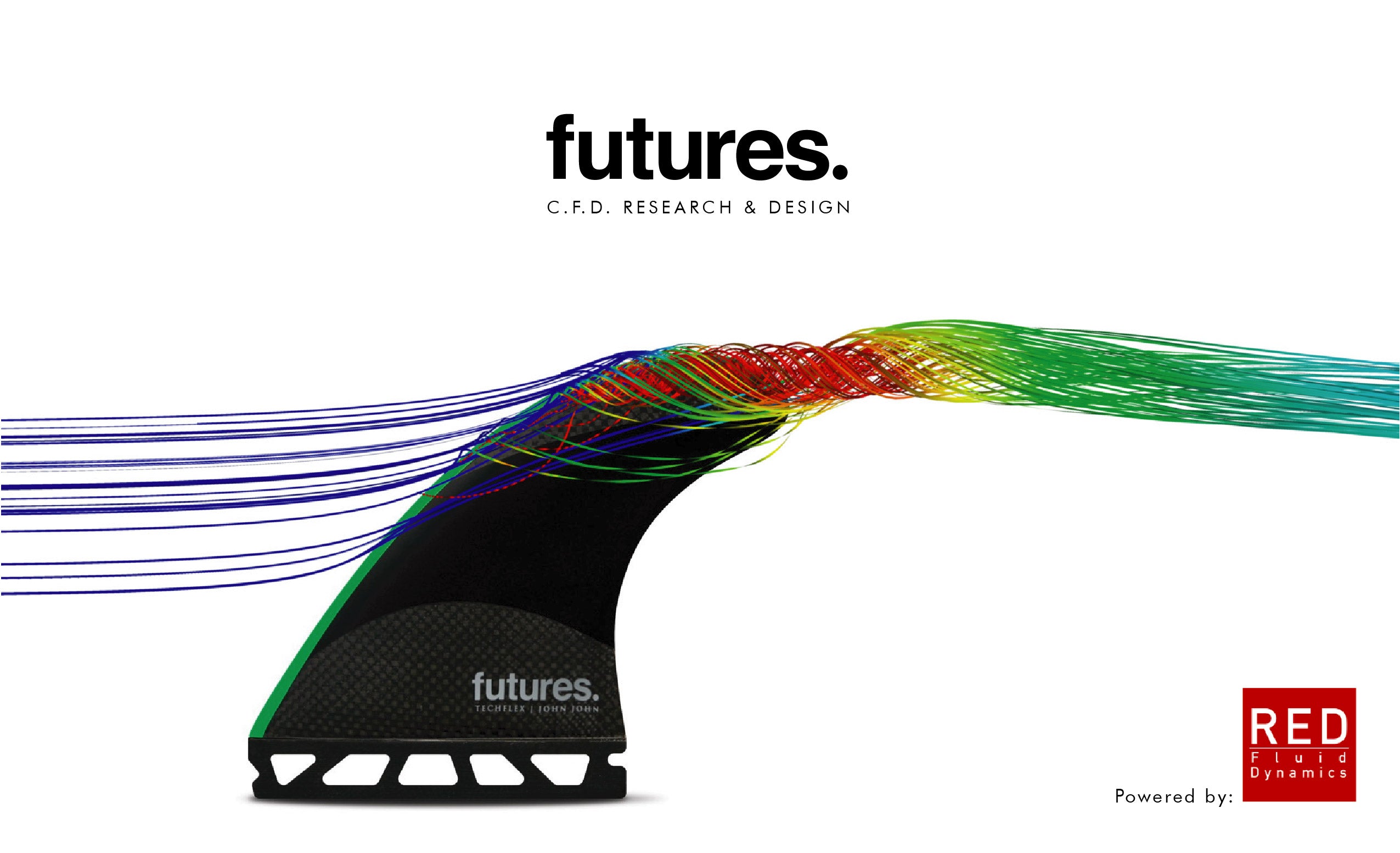C.F.D. - Research & Design

CFD • Computational Fluid Dynamics
Compu...what???
Computational fluid dynamics, or C.F.D. uses computer simulations to study and predict how water will interact with objects moving through it. It’s used to design and optimize all sorts of products that you see every day. Anything from cars and boats, to fans and even dish washers. Now the same science used to optimize performance race cars is being used on the fins right under your feet. We partnered with our friends over at Red Fluid Dynamics to run some tests on our fins and to put some hard numbers on the concepts that we’ve been designing fins around since ‘96.
From experience, we know that a template with more rake has more drive and an upright template allows for tighter turns. We know a fin with a tow foil (80/20) or a flat foil provides control when the waves are pumping, and a V2 foil helps to generate speed when you’re pumping. With our new CFD studies, we’re able to understand why exactly these characteristics (template, foil, and construction) have such big impacts on your surf experience and how we can refine our designs to make them even more impactful.
Simply put, the more we can understand, the better we can design and recommend the perfect fin for whatever surf style and surf conditions you experience.
Effects of Water Flow
-
Pressure - The force of water created on the surface of the fin as it flows across
High Pressure = Suction or hold
Low Pressure = Turbulence or water detaching from the surface of the fin
Pressure impacts how loose or stiff your board will feel when speed is generated. When pressure drops too low, fins break free or slide out. -
Pressure Differential - The difference in pressure from the inside surface of the fin to the outside surface of the fin.
High Pressure Differential = Speed Generating, Loose and Skatey Feel
Low Pressure Differential = Speed Controlling, Stable - Lift vs. Drag Ratio - More lift = More speed, projection and turning force Less drag = Less friction in the water and faster speed The combination of lift vs. drag gives the efficiency of the fin. The more lift a fin has, or the less drag it has, the higher the efficiency and thus, the faster you surf down the line.
The way the water flows around your fin determines its performance. CFD allows us to visualize the water flow and measure things like turbulence, pressure, and efficiency. Shown below, is a fin through out a top turn. The crazy swirling colors map the turbulence of the water around that fin. The colors go from smooth flow and high pressure to turbulent and low pressure as the angle of a turn gets more aggressive.
The more turbulent the water flow, the less efficient the fin is. This shows that when your fins break free and you slide out, you’re not able to generate any speed until your fins re-engage with the water. The angle at which your fins slide out has a lot to do with the template of the fin.

TEMPLATE
Surfing Style • Drive vs. Turnability
The rake of a fin has to do with how far the tip sticks out past the back of the fin base. The further the tip sticks out, the more Rake a fin has. Alternatively, the less the tip sticks out, the more upright the fin is.
This specific CFD analysis measures the pressure map on our three template categories (Rake, Neutral, Pivot). Blue is low pressure and Red is high pressure.
As you see below, the Raked fin has a much less concentrated pressure point (red) than the Pivot fin. This more equally distributed pressure throughout the Raked fin can equate to as much as a 12% increase in lift from a Pivot fin during the later part of a turn. This additional lift, or projection forward, accounts for the feeling of drive and drawn out turns in Raked templates. On upright fins, the pressure gets more concentrated in one place during a later part of a turn which gives less lift but allows for tighter turns and a more skatey feel.

FOIL
Wave Style • Stability vs. Speed
The foil shape of a fin (cross section) has the greatest impact on the pressure differential between the outside and inside surfaces. The shape of a foil can add as much as 30% more lift. That could easily be the difference between making a section or having to hit eject.
The V2 foil creates higher pressure differential, which creates more lift and speed to be generated. The lower pressure differential on Flat and Tow foils still generates lift, but creates more stability. V2 foils in pumping surf can be a little too skatey and unpredictable. Conversely, tow foils in small surf can feel like there’s less turning force and makes it harder to spring out of turns.
In our Ride Number terminology, ride Speed control fins when the waves are pumping, and speed generating fins when you’re pumping.
The Future











